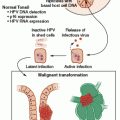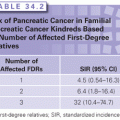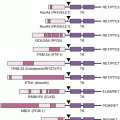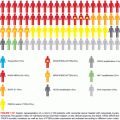Thus, countries with high incidence of intestinal-type gastric cancer (China, Korea, Japan, Portugal) use criteria analogous to the Amsterdam criteria invoked for Lynch syndrome:
• At least three relatives with intestinal gastric cancer, one a first-degree relative of the other two
• At least two successive generations affected, and
• Gastric cancer diagnosed before the age of 50 years in at least one individual
In countries with a low incidence of intestinal-type gastric cancer (United States, United Kingdom):
• At least two first-/second-degree relatives affected by intestinal gastric cancer, one diagnosed before the age of 50 years, or
• Three or more relatives with intestinal gastric cancer at any age
Familial intestinal gastric cancer families are similarly prevalent as familial diffuse gastric cancer families, yet a germ-line genetic defect underlying the disease remains to be identified.28 Hemminki et al.29 reported Swedish data on all available types of cancer in first-degree relatives by both parent and sibling probands. The relative risks (RR) for gastric cancer were greater than 3 for siblings with any relative with gastric cancer and greater than 5 when a sibling was younger than 50 years. Shin et al.30 assessed 428 gastric cancer subjects and 368 controls in Korea for the risk of gastric cancer in first-degree relatives and found an RR of 2.85 with one first-degree relative and greater than 5 in a first-degree relative with H. pylori and a positive family history. Therefore, in the high-incident countries of Japan and Taiwan, population screening for gastric cancer has greatly enhanced early detection, leading to 5-year survival rates of greater than 90%.31
Hereditary Diffuse Gastric Cancer
In 1999, the first IGCLC defined hereditary diffuse gastric cancer (HDGC) as families with (1) two cases diffuse gastric cancer in first-/second-degree relatives with one younger than 50 years, and (2) three cases diffuse gastric cancer at any age.32 The first clear evidence for a gastric cancer susceptibility genetic locus was the identification in 1998 of a germ-line inactivating mutation in the gene encoding for E-cadherin (CDH1) in a large, five-generation Maori family from New Zealand with 25 kindred with early-onset diffuse gastric cancer.33 The age at diagnosis of gastric cancer ranged upward from 14 years, with the majority occurring in individuals younger than 40 years. The pattern of inheritance of gastric cancer was consistent with an autosomal-dominant susceptibility gene with incomplete penetrance. Similar reports of CDH1 mutations in widely diverse HDGC cohorts from Asia, Europe, and North America followed soon thereafter.34–39 Germ-line CDH1 mutations have been found to be associated with approximately 30% of families with HDGC, with a lifetime risk for gastric cancer of greater than 80%, and up to 60% risk for female carriers developing lobular breast cancer.40 To date, CDH1 is the only gene implicated in HDGC. Worldwide, about 100 CDH1 mutation–positive families have been reported.41
E-cadherin Mutations and Gastric Cancer
The E-cadherin gene coding sequence gives rise to a mature protein consisting of three major domains, a large extracellular domain (exons 4 to 13), smaller transmembranes (exons 13 to 14), and cytoplasmic domains (exons 14 to 16). As in other autosomal-dominant cancer predisposing genes, only one CDH1 allele is mutated in the germ line, and the majority of genetic changes lead to truncation of the protein, with mutations distributed throughout the gene’s 2.6 kb of coding sequence and 16 exons without any apparent hotspots. Somatic CDH1 mutations have been identified in about half of sporadic diffuse gastric cancers, but occur rarely in intestinal gastric cancer. CDH1 encodes the calcium-dependent cell-adhesion glycoprotein E-cadherin. E-cadherin is a transmembrane protein that connects to the actin cytoskeleton through a complex with catenin proteins.5,42 Functionally, E-cadherin impacts the maintenance of normal tissue morphology and cellular differentiation. With regard to HDGC, it is believed that CDH1 acts as a tumor suppressor gene, with the mutation of CDH1 leading to a loss of cell adhesion, proliferation, invasion, and metastasis.43
Genetic Testing for HDGC
At the second meeting of the IGCLC in 2010, HDGC guidelines44 were extended to recommend CDH1 genetic testing to families with the following:
• Cases of gastric cancer in which one case is histopathologically confirmed as diffuse and younger than 50 years
• Families with both lobular breast cancer and diffuse gastric cancer, with one diagnosed younger than 50 years
• Probands diagnosed with diffuse gastric cancer younger than 40 years, with no family history of gastric cancer
Using the initial IGCLC criteria for HDGC, CDH1 mutation testing yielded a detection rate of 30% to 50%.45 Interestingly, a pattern began to emerge of lower CDH1 mutation rates among HDGC families in high gastric cancer incidence populations and higher rates in low-incident countries.46,47 Other reports suggest that the rate of CDH1 mutations in isolated cases of diffuse gastric cancer younger than 35 years is similar in both low- and high-risk countries, hovering at around 20%.48
Approximately 50% to 70% of clinically diagnosed HDGC families have no identifiable genetic mutation. Multiple candidate loci have been investigated without identifying causative mutations that would account for the large number of non-CDH1 HDGC families.49–51 Huntsman’s group has published a report of multiplex ligation-dependent probe amplification-based exon duplication/deletion studies performed on 93 non-CDH1 families and found 6.5% carried large genomic deletions, bringing the detection rate up to 45.6% in their cohort of 160 families.52
As CDH1 mutation families were identified, data on these families provided the foundation for genetic counseling information. Initially, the cumulative risk of gastric cancer by the age of 80 years in HDGC families was initially estimated as 67% for men and 83% for women. The age at onset shows marked variation between and within families. The median age at onset in the 30 Maori CDH1 mutation carriers who developed gastric cancer was 32 years, which was significantly younger than the median age of 43 years in individuals with gastric cancer from other ethnicities.53 More recent reports of the lifetime risks of diffuse gastric cancer suggest greater than 80% in both men and women by the age of 80 years.48,54
The lifetime risk for lobular breast cancer among female CDH1 carriers, originally estimated to be in the range of 20% to 40%, now approaches 60%, with an average age of 53 years at the time of diagnosis.36,54,55 Of note, CDH1 mutations have been seen in up to 50% of sporadic lobular breast cancer. Pathologic similarities between diffuse gastric and lobular breast carcinomas such as high mucin content with associated signet ring features and loss of E-cadherin on immunohistochemistry hint at a common molecular mechanism.56,57 To evaluate the CDH1 carrier rate in women with lobular breast cancer without a family history of diffuse gastric cancer, a multicenter study of 318 women with lobular-type breast cancer diagnosed before the age of 45 years and known to be BRCA1/2-negative were sequenced for CDH1 mutations. Only four possibly pathogenic mutations were identified for a rate of 1.3%, suggesting CDH1 is a rare cause of early lobular cancer without associated gastric cancer family history.58
Signet ring colon cancer has been reported in two families with germ-line CDH1, but no screening guidelines have been suggested.45,59 Nonsyndromic cleft lip and/or palate was reported in seven individuals from three families in the Netherlands and in four individuals from two families in France. There is speculation that defects in the cell-adhesion role of E-cadherin may contribute to this developmental anomaly, although no association can be drawn from these scant case reports.40,60
Like other familial cancer syndromes with an autosomal-dominant inheritance pattern, high penetrance for heterozygotes, and significant mortality unless diagnosed early, genetic counseling and testing should occur early, and a comprehensive screening plan should be developed, as well as the consideration of prophylactic surgery. Pretest and posttest genetic counseling should be provided to individuals from HDGC kindred who are undergoing genetic testing for germ-line CDH1 mutations. Because cases of gastric cancer in HDGC families have been reported in individuals as young as 14 years, HDGC may be considered one of the sets of hereditary cancer syndromes, such as MEN 2–associated medullary thyroid cancer, Li–Fraumeni syndrome (LFS), and familial adenomatous polyposis (FAP), in which genetic testing is potentially clinically useful in children.
SCREENING AND MANAGEMENT OF CANCER RISK IN HDGC
Diagnosing gastric cancer in its early stages provides the best chance for curative resection but is a difficult task. Symptoms due to gastric cancer are generally nonspecific and do not appear until the disease is more advanced. The survival of early gastric cancer (e.g., not beyond the mucosa or submucosa) is much better than advanced lesions, so identifying these lesions at the earliest of stages is imperative for optimal survival. Endoscopy is generally considered to be the best method to screen for gastric cancer, but diagnosing diffuse gastric carcinoma is most difficult, because these lesions tend not to form a grossly visible exophytic mass, but rather spread submucosally as single cells or clustered islands of cells. Improved chromoendoscopic-aided methods for directed biopsies to diagnose these early diffuse lesions may prove beneficial, but so far all approaches at screening, including computed tomography and positron emission tomography imaging, have proven disappointing.61
Given the inadequacy of clinical screening in HDGC, prophylactic total gastrectomy is offered to carriers of germ-line CDH1 mutations.62,63 In every published series of this approach, nearly all specimens contain multiple foci of intramucosal diffuse signet ring cell cancer. Currently, there is information available from 96 total gastrectomies in the setting of HDGC,44 approximately three-quarters of which were performed in asymptomatic CDH1 carriers following negative screening endoscopy and biopsies. Only three cases did not show evidence for early invasive carcinoma, and in two of these, tiny foci of in situ signet ring cell carcinoma were observed.44 Although malignant foci are generally localized to the proximal one-third of the stomach,64 lesions may be distributed throughout the entire stomach, necessitating a total gastrectomy for comprehensive prevention. The optimal timing of prophylactic gastrectomy is unknown but is generally recommended when the unaffected carrier is 5 years younger than the youngest family member who has developed clinical symptoms of HDGC. Clinical management and screening strategies remain uncertain for families who meet criteria for HDGC but are negative for CDH1 mutations or variants of unknown significance, although a screening endoscopy is often suggested.
The impact and long-term outcomes of prophylactic gastrectomy on carriers’ lifestyle and health are significant, particularly because 20% to 30% of carriers may never develop invasive gastric cancer. Certainly, all patients experience some level of morbidity, including diarrhea, weight loss, and difficulty eating. Mortality due to this indication for a gastrectomy has not been reported. Early evidence suggests that women can successfully carry healthy pregnancies after a gastrectomy.65 Most importantly, to date, there have been no reports of gastric cancer recurrence in a member of an HDGC family after a prophylactic total gastrectomy.
Women with HDGC also exhibit up to 60% lifetime risk for developing breast cancer, primarily of the lobular type, and as more women are prevented from developing diffuse gastric cancer, breast cancer screening is of great relevance. The correct approach to screening for lobular breast cancer in women with HDGC is not known, but is based on approaches used in other hereditary breast cancer susceptibility syndromes. Although prophylactic mastectomies have been shown to effectively prevent the development of breast cancer and result in improved long-term survival in BRCA1/2 mutation carriers, such an approach remains completely investigational for women in HDGC families. The prognosis of lobular cancers that develop in HDGC patients is currently unknown, and given the relatively late onset compared with breast cancers in BRCA1/2 carriers, prophylactic mastectomies may not be appropriate. Therefore, standard screening recommendations include annual breast magnetic resonance imaging (MRI) and mammogram starting at the age of 35 years.66,67An open question is whether chemoprevention with tamoxifen may benefit women with HDGC, given its role in reducing breast cancer risk in half in women at elevated risk because of age, family history, or history of biopsy-proven lobular carcinoma in situ.68
In summary, individuals from HDGC families with inherited germ-line mutations in the CDH1 gene face up to an 80% likelihood of developing gastric cancer and, for women, an additional 60% chance of developing lobular breast cancer during their lifetime, with significant risk beginning at relatively young ages. Such levels of overall cancer risk are similar to that of developing breast or colon cancer for carriers of BRCA1 or 2 gene mutations, or mismatch repair gene mutations, respectively. Therefore, rigorous surveillance and the consideration of prophylactic surgery are important for the management of these individuals. At the very least, a regular endoscopic examination with a random biopsy of the stomach should be performed every 6 to 12 months, probably starting 10 years earlier than the youngest affected patient in the family, or by the age of 25 years. Because mucosal abnormalities tend to occur late in diffuse gastric cancer and delay the endoscopic diagnosis, a prophylactic gastrectomy should be seriously considered as a means of preventing gastric carcinoma, although it clearly comes with high morbidity. It is somewhat less clear as to the correct approach for the screening and prevention of lobular breast cancer in women with HDGC. Adherence to standard recommendations for screening mammographies for breast cancer should be followed. The consideration of investigative approaches to screening with MRI and chemoprevention with tamoxifen or other agents are appropriate. The decision to perform a prophylactic gastrectomy should be balanced with age-based risk, based on age-specific penetrance data, as well as many other personal factors. Therefore, it is essential that patients carrying the gene have the opportunity for extensive counseling, discussion, and reflection with knowledgeable clinicians, geneticists, and counselors before making the decision to proceed.
OTHER HEREDITARY CANCER SUSCEPTIBILITY SYNDROMES WITH INCREASED GASTRIC CANCER RISK
Lynch Syndrome
The seminal report of a family with dominantly inherited colon and gastrointestinal (GI) cancers in 1979 by Lynch and Lynch69 began decades of defining and refining this hereditary syndrome. Lynch syndrome is caused by a germ-line mutation in a mismatch DNA repair gene (MLH1, MSH2, MSH6, PMS2, or EPCAM) and is thus associated with tumors exhibiting microsatellite instability (MSI). It is estimated that 2% to 4% of all diagnosed colorectal cancers70 and 2% to 5% of all diagnosed endometrial cancers71 are due to Lynch syndrome. With a frequency estimated at 1 in 440 in the United States,72 it is similar to the BRCA carriage rate. The lifetime risks for Lynch syndrome–associated cancers are highest for colorectal cancer at 52% to 82% (mean age at diagnosis, 44 to 61 years), followed by an endometrial cancer risk of 25% to 60% in women (mean age at diagnosis, 48 to 62 years), a 6% to 13% risk for gastric cancer (mean age at diagnosis, 56 years), and 4% to 12% for ovarian cancer (mean age at diagnosis, 42.5 years).70–78
Lynch syndrome–associated gastric cancers predominantly show intestinal histology (more than 90% of the cases). This correlation echoes the strong association between MSI tumor phenotype and intestinal gastric cancer. The International Collaborative Group on hereditary nonpolyposis colorectal cancer (HNPCC) developed the original Amsterdam Criteria in 1991. Revisions followed, with Bethesda criteria outlined in 1997 and revisions in 2004 with the inclusion of extracolonic tumor risks, including gastric cancer.79,80
MSI screening by molecular and/or immunohistochemistry for the four common Lynch protein products (MSH2, MSH6, MLH1, and PMS2) should be considered in families who meet the Bethesda criteria. Because 15% of all gastric tumors exhibit MSI histology, the majority of these have acquired this mutator phenotype through sporadic mutations, and further germ-line testing of individuals with MSI-positive tumors is necessary to confirm a molecular diagnosis of Lynch syndrome.
Hereditary Breast Ovarian Cancer Syndrome
Hereditary breast and ovarian cancer due to germ-line BRCA1 and BRCA2 mutations is perhaps the most well-defined and recognized inherited cancer syndrome. With a prevalence of 1 in 300 to 400 in most populations and up to 1 in 40 in selected groups with founder mutations (most notably those with Ashkenazi Jewish ancestry), it represents the most common of the hereditary disorders due to high-risk mutations. Carriers face a five- to six-fold increased risk of generally early-onset breast cancer and 10- to 20-fold increased risk for ovarian, fallopian, and primary peritoneal malignancies. Male carriers have a recognized increased risk for prostate cancer and male breast cancer. BRCA1 and BRCA2 have been implicated in multiple cellular functions but serve primary roles as tumor suppressor genes recruited to maintain genomic stability through DNA double-strand break repair. Following the cloning of the BRCA1 and BRCA2 genes in 1994 and 1995,81,82
Stay updated, free articles. Join our Telegram channel

Full access? Get Clinical Tree








